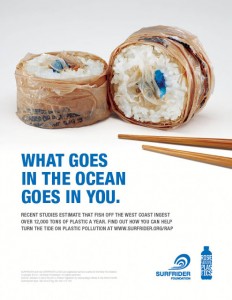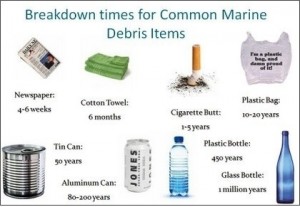Filling the Food Chain with Plastics
Dec 22nd, 2014 | By admin | Category: Consumption and WasteBy Suzanne York.
Oceans are the lungs of the planet, and make up 99% of it. Yet more and more, humans are using it as a garbage can. Many people have likely heard about the giant floating garbage dump in the Pacific Ocean – the Pacific Trash Vortex – which is full of discarded plastic, but that is only one part of the bigger problem.
A comprehensive study recently published in the journal PLOS One estimates that the ocean contains over 5 trillion pieces of plastic – nearly 260,000 tons, with plastic found even in remote areas. Much of this is referred to as “micro plastics” and measure less than 5mm.
Or, as Climate Progress put it, “The Ocean Now Has At Least 700 Pieces Of Plastic Per Person On Earth.”
In an attempt to firm up data on just what is out there, researchers surprisingly found low amounts of small piece of plastic debris. They noted that “fragmentation rates of already brittle microplastics may be very high, rapidly breaking small microplastics further down into ever smaller particles. Many recent studies also demonstrate that many more organisms ingest small plastic particles than previously thought.”
According to the New York Times, the fact that the small plastics are disappearing is hardly good news. “In fact, it could be far more troubling than the unsightly mess the plastics cause. Plastics attract and become coated with toxic substances like PCBs and other pollutants. Researchers are concerned that fish and other organisms that consume the plastics could reabsorb the toxic substances and pass them along to other predators when they are eaten.”
“Plastics are like a cocktail of contaminants floating around in the aquatic habitat,” said Chelsea M. Rochman, a marine ecologist at the University of California, Davis. “These contaminants may be magnifying up the food chain.”
Julia Reisser, a researcher with the University of Western Australia, told the Guardian, “We saw turtles that ate plastic bags and fish that ingested fishing lines. But there are also chemical impacts. When plastic gets into the water it acts like a magnet for oily pollutants.”
Here is a fitting and poignant excerpt from the book Sea Sick: Ocean Change and the Extinction of Life on Earth by Alanna Mitchell:
If all life on land were to vanish tomorrow, creatures in the ocean would flourish. If the opposite happened – if the ocean’s life perished – then the creatures on land would die too. Life, if it went on, would have to start over…
After millennia of insignificance, human actions and belief systems – what we do and how we think – have effected change on a scale that is damaging the ocean. Our actions are dangerous to us and to millions of other living things. We are altering not just bits of the sea with dreadful oil spills or eroding shores or vast extinctions of fish, but the whole, interconnected global system that is the ocean, the main medium of life on earth.
That is the crux of the matter. For all our intelligence and capabilities, the majority of humankind seems to either not get it or blithely ignores that we are part of the earth, that all things are connected.
For more on the state of the oceans, check out Mission Blue, a documentary about oceanographer Sylvia Earle and the rapid decimation of our oceans. Earle has dedicated her life to educating people on the beauty and importance of oceans and why we shouldn’t dump plastics and pollutants in a thriving ecosystem.
Suzanne York is a senior writer with the Institute for Population Studies.


